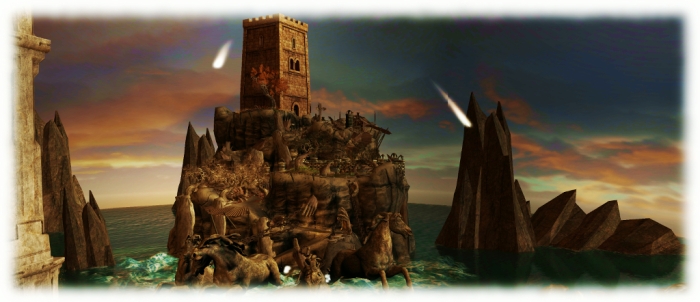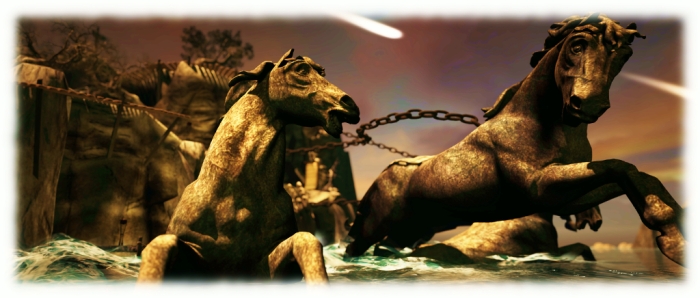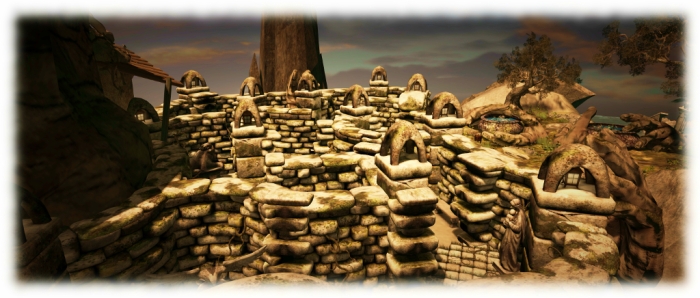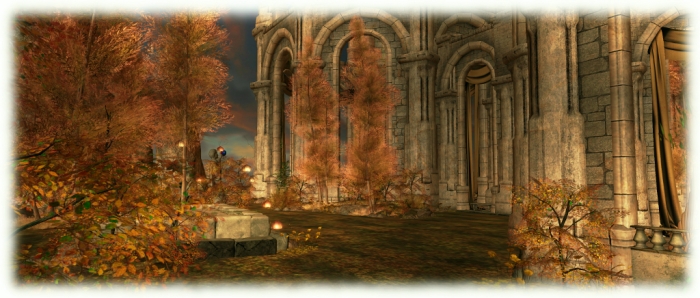
Update: To mark the anniversary of William Henley’s birth, Storm would like to hold a poetry event at Invictus at 15:00 SLT on August 23rd. She has a open invitation to Second Life poets and voice artists who would like to attend and read either their own work or that of their favourite poets (“even if it’s Dr. Seuss!” , she told me, eyes twinkling). If you are interested, please contact Storm via note card or via email.
Invictus (Latin: “unconquerable“) is the name of the full region installation by Storm Septimus, which is now open through until the end of 2016. It is a stunning visual interpretation of William Ernest Henley’s famous 1875 poem of the same name.
The poem, untitled at the time of its writing (editor Arthur Quiller-Couch added the title when including it in The Oxford Book of English Verse in 1900), came at a time when Henley was facing severe challenges. Diagnosed at an early age with tuberculosis of the bone, he had lost half his left leg to the disease in 1869, when he was just 20. Rather than accept the loss of his right leg as well, he spent three years hospitalised between 1873 and 1875 while noted surgeon Joseph Lister (ultimately successfully) fought to save the limb, and it was at the time of these multiple surgeries that Henley wrote his poem.

It is this determination of the human will to overcome adversity, no matter how dark, even with the portal of death awaiting, which forms the central theme of the poem. It takes the reader on a journey through life’s hardship, enduring the battering of circumstance and chance, to the recognition that whatever circumstance we face, we alone determine our fate. Dark through the initial three stanzas, the poem emerges in an affirmation of spiritual fortitude; a triumphant proclamation of self-will over fate, and our ability to lay claim to our time on Earth.
It’s a powerful message, and one evocatively presented within the installation, which offers a visual journey through the poem. This begins on the upper floor of a tower. Notes on navigation are presented on a scroll, and touching it will deliver them in note card form – recommended lest you find yourself forgetting directions.

To descend the tower is to descend into the black pit of the poem’s first stanza, which awaits at the lowest level. Outside, the journey continues, winding down a mountain, passing the remaining stanzas along the way, their surroundings reflecting and interpreting each in turn through metaphor and symbolism.
Any attempt to describe this journey is meaningless; it is something which is to be experienced first-hand. There is marvellously expressive symbolism to be found throughout; not only of the poem itself, but also the broader themes encompassed by its verses. Some of this is obvious, such as the giant hands grasping chain reins of great stallions, encapsulating the idea of taking control of one’s fate, reflecting the exultant final two lines of the poem.

Elsewhere, the symbolism is perhaps less obvious. Are the arrows found throughout the upper parts of the installation perhaps be a reference to “the slings and arrows of outrageous fortune”, a line from Shakespeare’s famous soliloquy on life and the nature of death? After all, the latter is not so very far removed from Henley’s own musings on the subject found within in the couplet, “Beyond this place of wrath and tears / Looms but the Horror of the shade”. Elsewhere we might also find reflections on the nature of life and death, and on he times in which Henley lived; the child-angels, for example, might be seen as a reminder of the high infant / child mortality rates in England in the mid-19th century.
This is also, I would suggest, something of a personal statement by Storm. Just as Henley used the poems written whilst hospital to explore his time as a patient, so Storm has used her art in Second life to explore her own circumstance through installations like 2015’s Failure to Thrive, exploring depression, or 2014’s examination of insomnia through The [Void] (which I wrote about here). Thus, within Invictus, it is hard to escape the feeling we’re being given a glimpse of Storm’s own self-affirmation the she, and not the challenges she faces, holds authority for her life.

Across the water from the mountain and tower lies the ruins of a cathedral set within a garden. Storm indicates this is not strictly a part of the poem’s interpretation, being intended for photography and events. However, it would seem to offer both a further motif for the more spiritual lines from Invictus and a contemplation of the calm certainty which follows the poem’s final two lines. To reach it, visitors can either fly or – in a more light-hearted nod to those final lines – by taking the rowing boat waiting at the foot of the mountain, thus figuratively becoming the “captains of their souls”.
SLurl Details
- Invictus (Rated: Moderate)
nice commercial 🙂 captain! Storm is a marster in details and storry telling. Go see by youerself!
LikeLike
wonderful post Inara ( as are most of yours though I don’t always comment). I must visit!
LikeLike
Do please visit! It is superb.
LikeLiked by 1 person
will do- I am not able to get in much as I’m packing for my big move!! Soon!!
LikeLike
Fingers crossed on the move!
LikeLiked by 1 person
oh yes!
LikeLike
I went to see this and its truly captivating!!!
LikeLike
The thing I liked the most about this build was that the resolution was not an easy “everything is beautiful” finale. The end maintains the autumnal patina of the entire journey, but with a battered beauty and serenity. I am sorry that I did not hear about Storm’s poetry event in time. “Invictus” is a personal favorite and I accidentally explored the installation backwards. Typical for me to flow against fate. *chuckles* But I am going back to explore it properly.
LikeLike
Nice observation on the cathedral and grounds, and one I’d missed. I need to head back once again and just wander once again.
LikeLike
Typical me, I landed and saw the cathedral on the resolution end of the poem first, and then crossed over and up the hill. Once I saw the end of the poem posted I was obsessed with finding the rest of it. Once I did, and realized what the intended flow of the build was, I went alllll the way back down to look for the visual resolution, because I was sure it was not just the waterside ruins and weeping angels. I have heard so many overwrought readings of this poem over the years, I was sure the artist could not have been so heavy handed as to not have included the strength of the ending. It is subtle, on the “inland” side of the cathedral walk – just the park (the only leaved trees in the build, I think), the floating lights, a single inviting bench. It is a quiet spot for momentary victory.
LikeLike
Oh, and among the few of my favorite reading of this poem is Morgan Freeman’s. The poem has such strength, and people tend to over play the end which is, like Storm’s build, not a moment of raging and fuming. “I am the master of my fate, I am the captain of my soul” is not said poetically with a shaken fist.
As an odd side note, it is supposed that his great friend, Robert Louis Stevenson, based one of his most famous characters on Henley — Long John Silver!
LikeLike
I prefer Bates’ rendition primarily because of the RP, which fits the flavour and metre of the poem.
As to RLS and the character of Long John Silver, Stevenson did indeed base the character on Henley, whom he met and became good friends with in 1875. Shortly after Treasure Island was published, and as a part of their ongoing friendship and collaborative efforts, he wrote to his great friend:
I will now make a confession: It was the sight of your maimed strength and masterfulness that begot Long John Silver … the idea of the maimed man, ruling and dreaded by the sound, was entirely taken from you.
Sadly, the latter half of their friendship (from 1888 through to Stevenson’s death in 1894) was marred by numerous quarrels, notably around Stevenson’s wife, whom Henley believed had plagiarised Katharine De Mattos.
LikeLike
I can see why you would prefer Bates. It is absolutely solid. I am afraid my “Left-Coast” ness is showing *laughs*
Intriguing that RLS should have drawn so ultimately true a portrait of Henley in Silver, then. Silver being the dubious hero, and inconstant villain – someone who plays by their own rules and for their own interests almost exclusively. It’s a cause for thought where Henley is concerned, and certainly RLS’s later life was filled with challenges.
I think I am going to choose to remember “Invictus” as one of Nelson Mandela’s favorite poems, and an invocation fro endurance and perseverance; rather than allow myself to deduce it into the fundaments of self-interest.
I am really enjoying chatting about this, but I suspect you would prefer I stop. “That’s nice Cale, BUT GIVE IT A REST!” *chortles* Thankee for the though provoking exchanges. One of the marvelous blessings of good art.
LikeLike
Conversation on art and expression is always welcome – hence why I enjoy our IM chats 🙂 . I think RLS took Henley as a model for LJS for the reasons he stated in his letter, coupled with the fact that Henley was physically and by nature, very much a larger than life character. There was also, as you deduce, a hint of rascal and perhaps a little inconstant. The initial disagreements between the two mean grew out of their attempts to collaborate in play-writing, an activity Henley appeared to be more a means to assuring a solid income and not a little fame rather than an endeavour of literally or creative expression or a desire to entertain (money was also the cause of upset between the two not long before RLS passed away, sadly).
And now I really must get back and immerse myself in Storm’s piece once again! 🙂 .
LikeLiked by 1 person
Oh definitely. I agree. “Treasure Island” would have been a much different story, I think, had the inspiration been influenced by the later conflict. I am reminded of a Neil Gaiman quote, “Nothing I ever did just for the money ever turned out, except as bitter experience. And sometimes I didn’t get the money either.”
I wonder if anyone is making a machinima of “Invictus”? Hmmmmmmmm . . . .
Enjoy the Journey! Maybe I’ll catch you there.
LikeLike